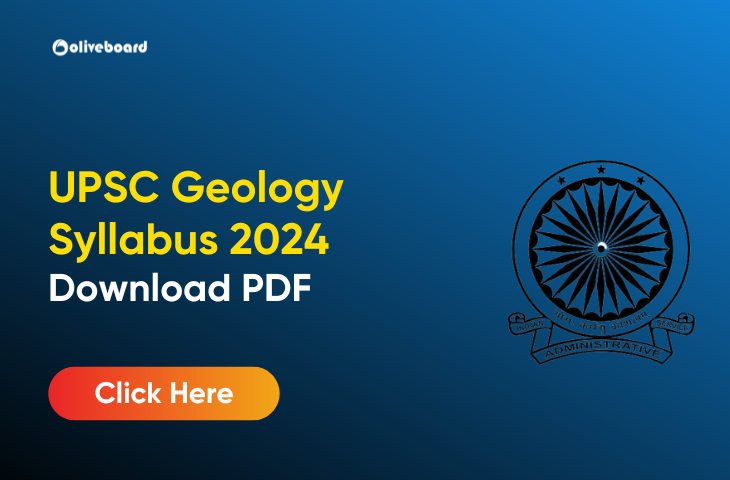UPSC Geology Syllabus 2024
The UPSC Geology syllabus 2024 covers key areas like general geology, geomorphology, oceanography, economic geology, and environmental geology. Topics include the origin and interior of the earth, major physiographic features, ocean floor topography, mineral resources, and natural hazards. Regular revision of core geology principles and relating them to current affairs is advised to score well in this section of the UPSC exam.
You can download the UPSC CSE Geology Syllabus from the direct link given below.
UPSC Geology Syllabus 2024 Overview
There is a list of optional subjects for mains in which there are 48 subjects, from which candidates can choose according to their choice. Geology is one of the optional subjects for the Civil Services Exam conducted by UPSC. The optional paper is conducted for 250 marks. The UPSC CSE optional subject Geology Syllabus 2024 has two papers, Paper 1 and Paper 2.
Geology Syllabus 2024 for UPSC CSE
If you opt for Agriculture optional in UPSC mains, prepare it thoroughly. Go through the UPSC CSE Syllabus and previous years’ Agriculture papers. Also study relevant Agriculture books for UPSC preparation.
The UPSC Geology syllabus emphasizes building a strong foundation in basic concepts which can be applied to sustainable development and disaster management issues. Key topics include general geology, remote sensing, India’s landforms, stratigraphy, mining, economic geology and their interlinkages. Aspirants should focus on understanding core principles and relating them to real-world problems.
UPSC CSE Geology Syllabus 2024 Paper 1
1. General Geology:
- The Solar System, meteorites, origin and interior of the earth, and age of the earth
- Volcanoes: causes, products, and volcanic belts
- Earthquakes: causes, effects, seismic zones of India
- Island arcs, trenches, and mid-ocean ridges
- Continental drift, seafloor spreading, plate tectonics
- Isostasy
2. Geomorphology and Remote Sensing:
- Basic concepts of geomorphology
- Weathering and soil formations
- Landforms, slopes, and drainage
- Geomorphic cycles and their interpretation
- Morphology and its relation to structures and lithology
- Coastal geomorphology
- Applications of geomorphology in mineral prospecting, civil engineering, hydrology, and environmental studies
- Geomorphology of the Indian sub-continent
- Aerial photographs and their interpretation: merits and limitations
- The Electromagnetic spectrum
- Orbiting Satellites and Sensor Systems
- Indian Remote Sensing Satellites
- Satellite data products
- Applications of remote sensing in geology
- The Geographic Information System (GIS) and Global Positioning System (GPS): its applications
3. Structural Geology:
- Principles of geologic mapping and map reading, projection diagrams
- Stress and strain ellipsoid and stress-strain relationships of elastic, plastic, and viscous materials
- Strain markers in deformed rocks
- Behaviour of minerals and rocks under deformation conditions
- Folds and faults classification and mechanics
- Structural analysis of folds, foliations, lineations, joints, and faults, unconformities
- Time-relationship between crystallization and deformation
4. Paleontology:
- Species: definition and nomenclature
- Megafossils and Microfossils
- Modes of preservation of fossils
- Different kinds of microfossils
- Application of microfossils in correlation, petroleum exploration, paleoclimatic, and paleoceanographic studies
- Evolutionary trend in Hominidae, Equidae, and Proboscidae
- Siwalik fauna
- Gondwana flora and fauna and its importance
- Index fossils and their significance
5. Indian Stratigraphy:
- Classification of stratigraphic sequences: lithostrati-graphic, biostratigraphic, chronostratigraphic, and magnetostratigraphic
- Distribution and classification of Precambrian rocks of India
- Study of stratigraphic distribution and lithology of Phanerozoic rocks of India with reference to fauna, flora, and economic importance
- Major boundary problems—Cambrian/Precambrian, Permian/Triassic, Cretaceous/Tertiary, and Pliocene/Pleistocene
- Study of climatic conditions, paleogeography, and igneous activity in the Indian sub-continent in the geological past
- Tectonic framework of India
- Evolution of the Himalayas
6. Hydrogeology and Engineering Geology:
- Hydrologic cycle and genetic classification of water
- Movement of subsurface water; Springs
- Porosity, permeability, hydraulic conductivity, transmissivity, and storage coefficient; classification of aquifers
- Water-bearing characteristics of rocks
- Groundwater chemistry; Salt water intrusion
- Types of wells; Drainage basin morphometry
- Exploration for groundwater; Groundwater recharge
- Problems and management of groundwater; Rainwater harvesting
- Engineering properties of rocks; Geological investigations for dams, tunnels, highways, railway, and bridges
- Rock as a construction material
- Landslides causes, prevention, and rehabilitation
- Earthquake-resistant structures
UPSC CSE Geology Syllabus 2024 Paper 2
1. Mineralogy:
- Classification of crystals into systems and classes of symmetry
- International system of crystallographic notation
- Use of projection diagrams to represent crystal symmetry
- Elements of X-ray crystallography
- Physical and chemical characters of rock-forming silicate mineral groups
- Structural classification of silicates
- Common minerals of igneous and metamorphic rocks
- Minerals of the carbonate, phosphate, sulphide, and halide groups
- Clay minerals
- Optical properties of common rock-forming minerals
2. Igneous and Metamorphic Petrology:
- Generation and crystallisation of magmas
- Crystallisation of albite—anorthite, diopside—anorthite, and diopside—wollastonite—silica systems
- Bowen’s Reaction Principle
- Magmatic differentiation and assimilation
- Petrogenetic significance of the textures and structures of igneous rocks
- Petrography and petrogenesis of various rock groups
- Deccan volcanic province
- Types and agents of metamorphism
- Metamorphic grades and zones
- Phase rule
- Facies of regional and contact metamorphism
- ACF and AKF diagrams
- Textures and structures of metamorphic rocks
- Metamorphism of arenaceous, argillaceous, and basic rocks
- Minerals assemblages
- Retrograde metamorphism
- Metasomatism and granitisation
- Migmatites
- Granulite terrains of India
3. Sedimentary Petrology:
- Sedimentas and Sedimentary rocks
- Processes of formation, diagenesis, and lithification
- Clastic and non-clastic rocks: classification, petrography, and depositional environment
- Sedimentary facies and provenance
- Sedimentary structures and their significance
- Heavy minerals and their significance
- Sedimentary basins of India
4. Economic Geology:
- Ore, ore mineral, and gangue, tenor of ore
- Classification of ore deposits
- Processes of formation of mineral deposits
- Controls of ore localisation
- Ore textures and structures
- Metallogenic epochs and provinces
- Geology of important Indian deposits
- National Mineral Policy
- Conservation and utilization of mineral resources
- Marine mineral resources and Law of Sea
5. Mining Geology:
- Methods of prospecting: geological, geophysical, geochemical, and geobotanical
- Techniques of sampling
- Estimation of reserves of ore
- Methods of exploration and mining
- Mineral beneficiation and ore dressing
6. Geochemistry and Environmental Geology:
- Cosmic abundance of elements
- Composition of the planets and meteorites
- Structure and composition of the earth and distribution of elements
- Trace elements
- Elements of crystal chemistry
- Elementary thermodynamics
- Natural hazards and mitigation
- Environmental impact assessment
- Pollution of ground and surface water, marine pollution
- Legislative measures in India for environmental protection
- Sea level changes: causes and impact
To get more UPSC Optional paper syllabus PDF, check: UPSC CSE Optional Paper Syllabus
| Important Links | Important Links |
| UPSC CSE 2024 Apply Online | UPSC CSE 2024 Notification |
| UPSC CSE Eligibility Criteria | UPSC CSE Syllabus |
| UPSC CSE Exam Pattern | UPSC CSE Selection Process |
UPSC CSE Geology Syllabus 2024 FAQs
The UPSC Geology optional paper syllabus 2024 covers key areas like general geology, geomorphology, oceanography, economic geology, and environmental geology. Topics include the origin and interior of the earth, major physiographic features, ocean floor topography, mineral resources, and natural hazards.
Get syllabus PDF here: UPSC CSE Geology Syllabus
There is 250 marks is for one optional paper.

Hello, I’m Aditi the creative mind behind the words at Oliveboard. As a content writer specializing in state-level exams, my mission is to simplify complex exam information and help aspirants navigate their journey with clarity and confidence.
Having walked the path of an aspirant myself, I bring a unique, relatable perspective to my work. I focus on crafting accessible and accurate content on Exam Notifications, Admit Cards, and Results, ensuring candidates have the right information at the right time.
At Oliveboard, I play a key role in empowering students by breaking down the exam process into understandable and actionable insights. My aim is to make preparation less daunting and more rewarding, one well-informed step at a time.
